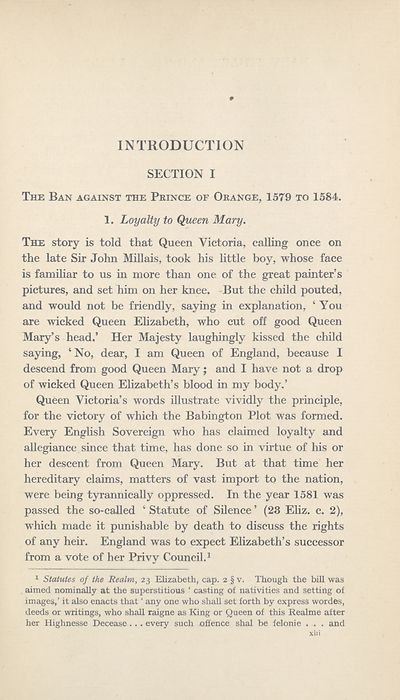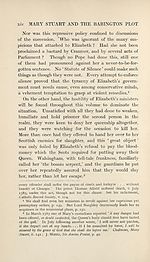Series 3 > Mary Queen of Scots and the Babington plot
(18) Page xiii - Introduction
Download files
Complete book:
Individual page:
Thumbnail gallery: Grid view | List view

INTRODUCTION
SECTION I
The Ban against the Prince of Orange, 1579 to 1584.
1. Loyalty to Queen Mary.
The story is told that Queen Victoria, calling once on
the late Sir John Millais, took his little boy, whose face
is familiar to us in more than one of the great painter’s
pictures, and set him on her knee. But the child pouted,
and would not be friendly, saying in explanation, ‘ You
are wicked Queen Elizabeth, who cut off good Queen
Mary’s head.’ Her Majesty laughingly kissed the child
saying, ‘No, dear, I am Queen of England, because I
descend from good Queen Mary; and I have not a drop
of wicked Queen Elizabeth’s blood in my body.’
Queen Victoria’s words illustrate vividly the principle,
for the victory of which the Babington Plot was formed.
Every English Sovereign who has claimed loyalty and
allegiance since that time, has done so in virtue of his or
her descent from Queen Mary. But at that time her
hereditary claims, matters of vast import to the nation,
were being tyrannically oppressed. In the year 1581 was
passed the so-called ‘ Statute of Silence ’ (23 Eliz. c. 2),
which made it punishable by death to discuss the rights
of any heir. England was to expect Elizabeth’s successor
from a vote of her Privy Council.1
1 Statutes of the Realm, 23 Elizabeth, cap. 2 § v. Though the bill was
aimed nominally at the superstitious ‘ casting of nativities and setting of
images,’ it also enacts that ‘ any one who shall set forth by express wordes,
deeds or writings, who shall raigne as King or Queen of this Realme after
her Highnesse Decease . . . every such offence shal be felonie . . . and
SECTION I
The Ban against the Prince of Orange, 1579 to 1584.
1. Loyalty to Queen Mary.
The story is told that Queen Victoria, calling once on
the late Sir John Millais, took his little boy, whose face
is familiar to us in more than one of the great painter’s
pictures, and set him on her knee. But the child pouted,
and would not be friendly, saying in explanation, ‘ You
are wicked Queen Elizabeth, who cut off good Queen
Mary’s head.’ Her Majesty laughingly kissed the child
saying, ‘No, dear, I am Queen of England, because I
descend from good Queen Mary; and I have not a drop
of wicked Queen Elizabeth’s blood in my body.’
Queen Victoria’s words illustrate vividly the principle,
for the victory of which the Babington Plot was formed.
Every English Sovereign who has claimed loyalty and
allegiance since that time, has done so in virtue of his or
her descent from Queen Mary. But at that time her
hereditary claims, matters of vast import to the nation,
were being tyrannically oppressed. In the year 1581 was
passed the so-called ‘ Statute of Silence ’ (23 Eliz. c. 2),
which made it punishable by death to discuss the rights
of any heir. England was to expect Elizabeth’s successor
from a vote of her Privy Council.1
1 Statutes of the Realm, 23 Elizabeth, cap. 2 § v. Though the bill was
aimed nominally at the superstitious ‘ casting of nativities and setting of
images,’ it also enacts that ‘ any one who shall set forth by express wordes,
deeds or writings, who shall raigne as King or Queen of this Realme after
her Highnesse Decease . . . every such offence shal be felonie . . . and
Set display mode to:
![]() Universal Viewer |
Universal Viewer | ![]() Mirador |
Large image | Transcription
Mirador |
Large image | Transcription
Images and transcriptions on this page, including medium image downloads, may be used under the Creative Commons Attribution 4.0 International Licence unless otherwise stated. ![]()
| Scottish History Society volumes > Series 3 > Mary Queen of Scots and the Babington plot > (18) Page xiii - Introduction |
|---|
| Permanent URL | https://digital.nls.uk/127234257 |
|---|
| Attribution and copyright: |
|
|---|
| Description | Over 180 volumes, published by the Scottish History Society, containing original sources on Scotland's history and people. With a wide range of subjects, the books collectively cover all periods from the 12th to 20th centuries, and reflect changing trends in Scottish history. Sources are accompanied by scholarly interpretation, references and bibliographies. Volumes are usually published annually, and more digitised volumes will be added as they become available. |
|---|


